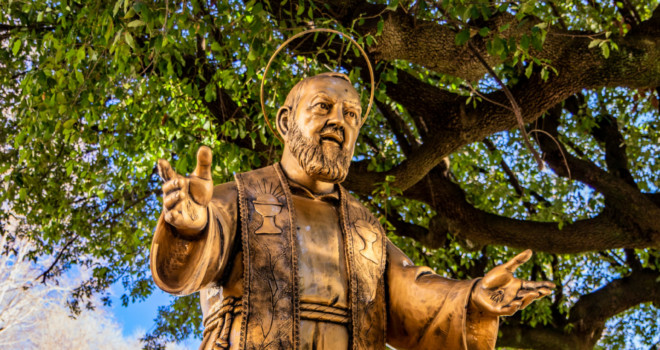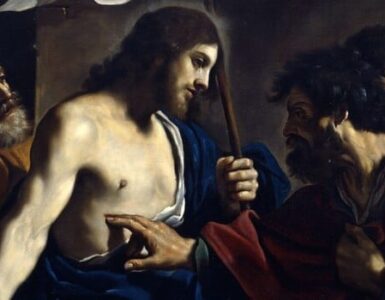“Do not leave the altar without first shedding tears of sorrow and love for Jesus, crucified for your eternal salvation. Our Lady of Sorrows will keep you company and inspire you.”
—St. Padre Pio
What does it mean to be hidden, to carry a burden no one can see or touch or understand, no one but God alone? There is a particular crucifixion of the heart—what St. Padre Pio defined as the transverberation of the heart—because a heart that is hidden knows that love and suffering cannot be separated.
When St. Padre Pio was first pierced with the stigmata, he learned quickly that love is a sort of death. The paradox of love-in-suffering became manifest from that day onward, and he understood a sort of mystical piercing of the heart that relates back to the sword in the heart of Our Lady. This may well be the reason for his devotion to Our Lady of Sorrows, because he also experienced this wound in his heart that Jesus transformed into love.
Suffering for us, too, can translate into this spiritual paradox of love-in-suffering. The physiological evidence of a broken heart has been documented by scientists, in the sense that the heart does, in fact, feel pain when it suffers loss. Grief, when it is prolonged like an interminable winter, becomes a season of suffering. And the strange fact is that this stretch of life can actually increase a person’s capacity to love.
A wounded heart can become the source of a greater love.
Most of us will never understand why horrific suffering befalls the holiest of people. At the same time, as we draw nearer to Jesus, He invites us into His Passion, as well. In this manner of suffering—a very specific invitation—St. Padre Pio was granted extraordinary graces to impart on the people who came to him for healing. It’s the very woundedness of his body and heart that became the impetus for healing to others.
The same can be true of our own pained hearts. I think often of Psalm 139 that reads, “the darkness is not dark to you; the night will shine like the day, for darkness is as light to you.” God created both the light and the darkness. It is in this mystery of darkness of suffering where we can, if we follow in the footsteps of mystical saints like St. Padre Pio, learn how to love in a pure and complete way.
Suffering can repel and embitter us, or it can draw us nearer to God. Though never part of God’s perfect will, nothing is wasted if we continually unite our wounds to those of the Sacred Heart of Jesus. There comes a point in our own grief when we realize that God may not take away our suffering. Our cross will always be a part of life, and the burden will remain—sometimes crushing, sometimes “easy and light” under the ease of grace.
The point is not that we ask our suffering to be removed, but to be transformed into love. And that is what the transverberation of the heart meant to St. Padre Pio and to so many other saints who called it by other names. It means to still suffer the pangs of loss in the heart, to still experience, in whatever capacity we are called to participate, in the Passion of Jesus. Yet we do suffer in love.
Maybe we will never learn to suffer perfectly during our earthly pilgrimage. But the point is not necessarily perfection (which is reserved for heaven); it is to suffer well. That might look like carrying an invisible cross—mental illness, migraines, chronic fatigue, autoimmune disease, arthritis—that becomes our gateway to love.
Suffering, when offered continually to Jesus, makes us more tolerant of the suffering around us, too. We become more patient, more perseverant, more compassionate. Without our personalized cross and the heart pains that accompany what we go through, we may not otherwise become refined in the particular virtues necessary for our sanctification.
The example of St. Padre Pio’s quiet suffering translates into how we might allow ourselves to be poured out, like the blood and water gushing from Jesus’s side, as an offering to God, that He might fill us with Himself. Only when we accept whatever God permits, including the greatest of darkness and suffering, can our hearts expand to love more fully, deeply, and completely.
✠
image: Bronze statue of Saint (Father) Pio of Pietrelcina (Frascati) by Ragemax / Shutterstock.com












